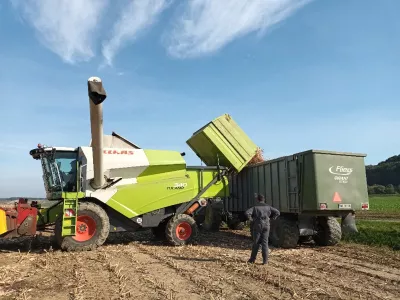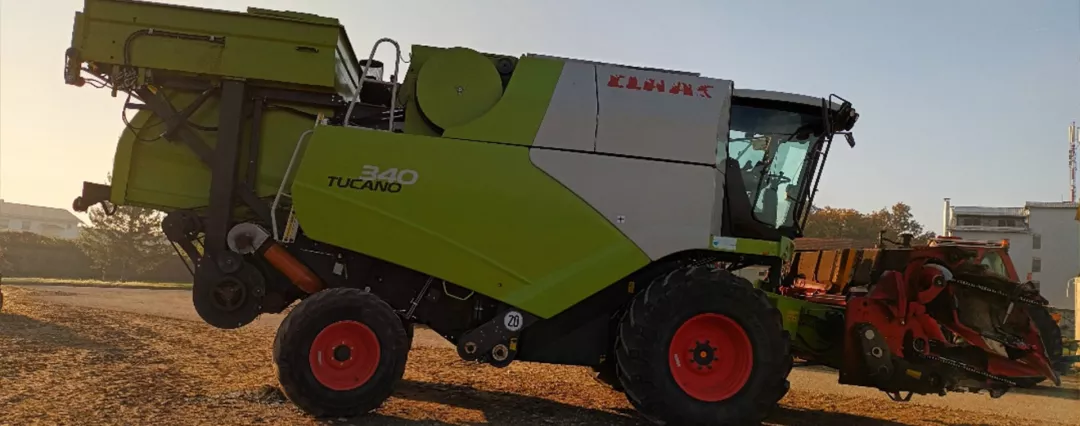General information
RDP Priority
- P1. Knowledge transfer and innovation
RDP Focus Area
- 1A: Innovation & cooperation
- 1B: Links with research & innovation
RDP Measure
- M16: Cooperation
Beneficiary type
- Operational group
Summary
When corn is harvested, corn husks are usually left on the field as a discarded by-product. However, corn husks can be used as a source of energy for fuel and in many other applications, such as building insulation in construction, bedding and animal feed in agriculture, and as a raw material for the synthesis of ethanol, furfural, xylitol, etc., in the chemical industry.
Slovenia's ŽIPO Lenart Ltd. agricultural company launched an EIP project to develop a machine for harvesting and storing corn kernels and husks. The EIP Operational Group (OG) also tested different corn hybrids to identify the most suitable options to produce corn cobs and corn husks.
Results
- At least 80 farms used corn husks as fuel after the project was completed. This boosted their incomes through greater energy self-sufficiency.

Funding
Total budget: 255 208 (EUR)
EAFRD: 199 730 (EUR)
National/Regional: 43 932 (EUR)
Private/own: 11 546 (EUR)
Resources
Documents
Links
Context
The lead project partner of the EIP Operational Group (OG), ŽIPO Lenart Ltd., is an agricultural company engaged in primary production covering both agriculture and animal husbandry. The company has a modern grain dryer for agricultural processing.
Above all, the company’s business model is based on the principles of circular economy and sustainable agriculture, as well as on self-sufficiency by using renewable energy sources. The company saw that there was great potential in the use of corn husks as this by-product of corn harvests has a good energy value. Corn husks are produced at the same time as food/feed (maize) and, though they are usually discarded, can be used as a fuel for drying or heating systems, in construction as building insulation, as an additive for animal feed, as bedding material and in the chemical industry as a raw material for the synthesis of ethanol, furfural, xylitol, etc.
At ŽIPO Lenart Ltd., the biggest challenge was developing a method for harvesting corn husks. Since their value and potential uses are still unknown to many, only a few devices for harvesting corn husks have been developed so far.
Objectives
The main aims of this OG were to develop a technical solution for harvesting corn husks and learn more about the thermal (and other) properties of corn cobs.
Activities
Project activities included:
- Managing and coordinating the project.
- Designing the test phase (i.e. selecting suitable maize hybrids, sowing, implementing agrotechnical actions, etc.).
- Exploring the thermal characteristics and other properties and potential uses of corn husks. Transferring and disseminating this knowledge to other stakeholders by organising trainings, demonstrations, open days, media communications, etc.
- Examining possible technical solutions for harvesting corn husks and transferring and disseminating knowledge in different ways.
- Modifying and upgrading the Class Tucano 340 corn harvester. The OG modified the interior of the machine and added a storage tank for corn husks to the outside. With these adaptations, it is possible to harvest corn kernels and corn cobs simultaneously without obstructing the harvest itself.
- Analysing the properties of maize husks (ash analysis, energy value, etc.).
- Reviewing and analysing post-harvest data including yield per hectare, purity of husks, yield according to individual hybrids and yields on different farms.
The OG partners were Žipo Lenart Ltd. (lead partner), the Institute of Agriculture and Forestry Maribor, Interkorn Ltd., National Laboratory of Health, Environment and Food, Faculty of Agriculture and Life Science Maribor, ProFuturus Ltd., and the agricultural holdings of Anita Števanec, Matej Korošec, Boštjan Kraner and Franc Horvat.
Main results
- Higher incomes have been achieved.
- Since the completion of the project, almost 80 farms that use corn husks as fuel have achieved greater energy self-sufficiency.
- The overall use of fossil fuels has decreased across these participating farms.
Key lessons
- Wide participation in the project’s knowledge sharing actions demonstrated that there is an ever-increasing interest in renewable energy and energy self-sufficiency, particularly where solutions combine nature conservation and environmental protection.
- A successful OG should be based on reliability and good communication between the project partners. OG goals should be realistic and achievable. Risk foresight can help manage expectations. A lot of good communication is required. Dedicating specific time and resources for meetings and conversations is a key to success.
